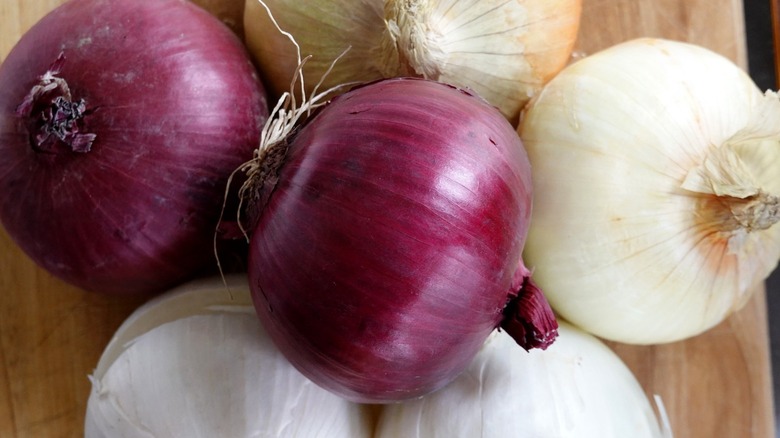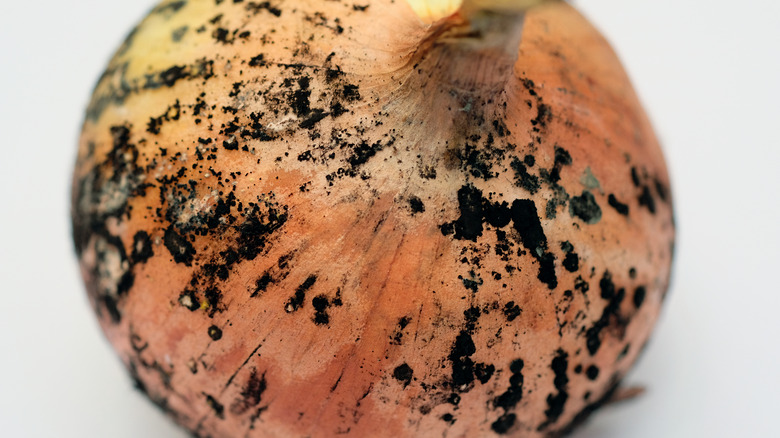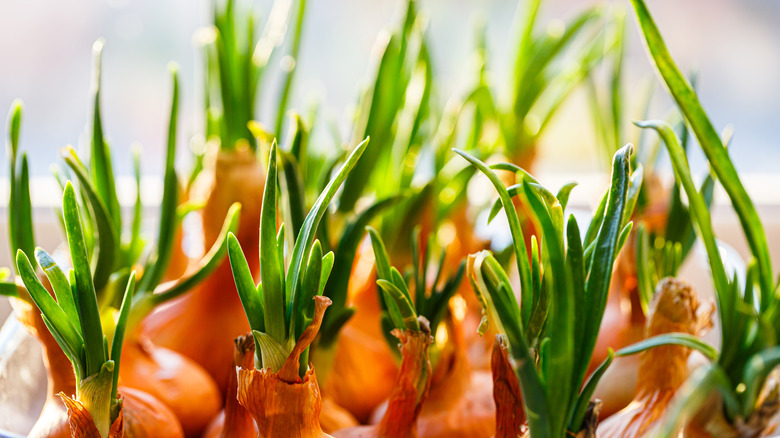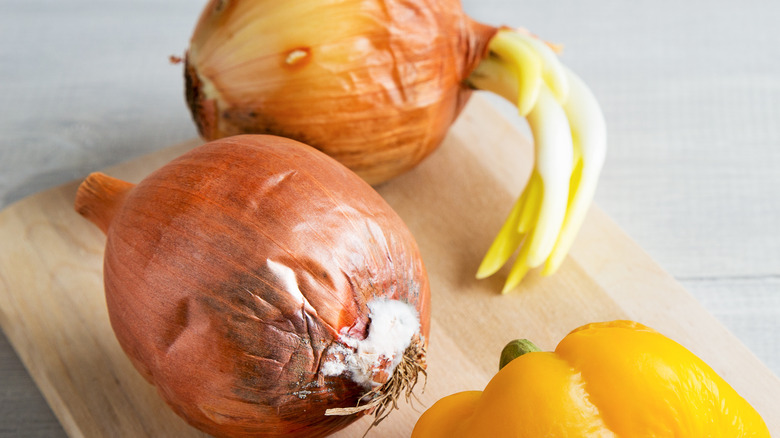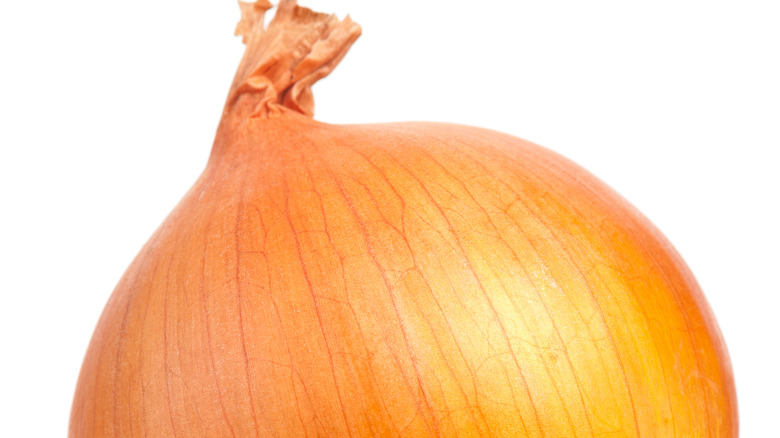How To Tell If An Onion Has Gone Bad
Onions are one of the most pervasive vegetables in the world. It can seem like nearly every savory recipe starts with them, and you'll find them across all types of cuisines, according to the BBC. Many of you probably have at least one in your kitchen right now.
There are many types of onions; they can be broken down into categories based on color, such as yellow Walla Walla or pungent red, or by type like storage or soft. Yellow, red, and white onions are storage; this means "they're cured (i.e., laid out to dry) after they're harvested, usually in late summer, [and] they'll keep in your kitchen for months if stored properly," according to Bon Appétit. Soft onions are more fragile, making refrigeration recommended.
Storing onions properly is the best way to prevent spoilage and prolong their shelf life. According to Eat By Date, onions are best stored at room temperature, without too much light or moisture, avoiding "plastic bags or any closed containers that can't breathe." When kept correctly, Recipe Marker reports that they last for around four to six weeks at room temperature, and one to two months in the fridge. Although, it's important to note that this timeline is cut down drastically to about a week if the onion is cut and removed from its protective skin, according to Does It Go Bad.
Watch out for mold
On the exterior of the onion, one thing to look out for is mold. Sometimes mistaken for dirt or soot, black spots on the onion paper are often a fungus called Aspergillus niger (via The Columbus Dispatch.) You can find this specific mold in soil, or in the onion seeds, reports The Eagle. It grows when onions are bruised, damaged, or stored poorly. If found on the inside of the onion, the writer recommends throwing it away.
Beyond Aspergillus niger, there are other types of mold to watch out for. Pale-yellow and later blue-green powdery mold, Penicillium, is also a common fungus that gets into the bulb through cuts and bruising. And, according to The University of California Agriculture and Natural Resources, "Once inside the bulb, the mycelium grows through the fleshy scales, eventually sporulating profusely on the surface of lesions and wounds." Since visible mold is a colony of microscopic spores, even if you successfully clean off all the mold you can see, there are likely still spores that you can't see (via the U.S. Department of Agriculture). In general, mold in a soft food is a sign that it is bad, so it's best to toss it in the trash, according to Healthline.
Sprouting onions are aging but safe to eat
Sprouting is another easily identifiable sign that your onions might be on their way out. This looks like green stalks, similar in appearance to a thick chive or a scallion, growing out of the top of the onion. These sprouts are a sign of aging, as Recipe Maker reports that the growth "means that it has been sitting on the store's shelf long enough to grow leaves. So, while an onion with sprouts can still look fresh, keep in mind that it has already spent a fraction of its shelf life at the grocery, which means it will have a shorter life span in your pantry."
Sprouting is a natural part of an onion's life span, so it's thankfully not a sign of something gone wrong but rather a normal part of new growth for the plant. The sprout lies dormant in the onion, and when conditions are right, like high environmental moisture, the onion starts the process of the next stage of its lifecycle (via Times of India.) Luckily, as The Kitchn reports, sprouted onions (and their sprouts) are totally safe to eat, although some may find the bitter taste to be off-putting. Sprouting onions do go bad quicker, and release ethylene gas which can encourage more sprouting, so make sure to keep them separate from other produce, warns Times of India.
Beware of soft spots and bruising
Like all produce, the ride from the farm to the grocery store to your kitchen counter can be a bumpy one. A certain amount of knocking around is obviously to be expected, but once an onion's flesh gets a cut or a bruise, that's when the trouble starts. A hard knock can lead to bruising that can also show on the skin. A bruise can lead to rot and molding very quickly (via Does It Go Bad.)
Softness is a sign of the onion starting to break down and is the beginning of rotting (via Home Cook Basics.) But a small soft spot doesn't necessarily mean the whole onion is rotten. As Recipe Marker reports, a bruise or soft, slimy spot on the outside of the onion can look a lot worse than it is; sometimes, it's possible to peel back the affected layers and salvage the rest of the bulb inside. To assess whether the interior is compromised without cutting into the onion and peeling back the layers, Recipe Marker also recommends giving the onion a quick squeeze. A healthy onion will be firm, while a rotten one will feel soft and spongey all the way through.
Use the sniff test
If the exterior of the onion doesn't have any mold, sprouts, or prominent soft spots, the classic sniff test can help you assess if your onion has gone bad. Sometimes the outside of the onion looks totally fine, but once it has been cut into, it's clear that the inside has gone bad, and it's not usable after all. Most produce has a super noticeable putrid smell when it goes bad, but onions can be a little more tricky.
Even the freshest, healthiest onion can have an extremely strong and sometimes unpleasant smell. If your onion has the classic onion-y funk but is just more intense, it's likely fine. But, if you also get a whiff of a compost-like smell in addition to the onion's signature sharpness, then that's a pretty good indication that the onion has gone bad, according to MedMunch. As Allrecipes reports, if you notice your onion changing smell over time in any way, that's usually a good indicator something's not right. This change in scent results from microbes like bacteria, mold, and yeast decomposing the onion as it rots, reports Tufts, adding in an additional valuable piece of advice, "When in doubt, throw it out."
